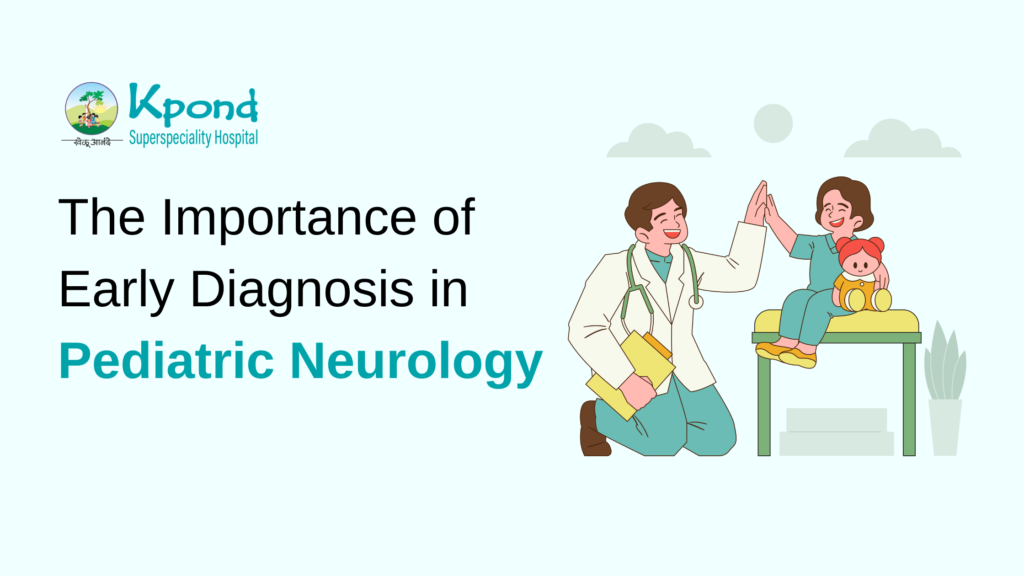Category: Blog

Early diagnosis in paediatric neurology is critical for ensuring the best possible outcomes for children with neurological disorders. These conditions can range from relatively mild issues, such as headaches or developmental delays, to more severe and life-altering conditions, such as epilepsy, cerebral palsy, or muscular dystrophy. Early detection and intervention can dramatically impact a child’s development, quality of life, and long-term prognosis.
This blog explores why early diagnosis is vital and the steps parents and healthcare providers can take to ensure timely identification and treatment of neurological disorders in children.
The Role of Pediatric Neurology
Paediatric neurology is a specialised field that focuses on diagnosing, treating, and managing neurological disorders in children. These disorders affect the brain, spinal cord, nerves, and muscles, and can manifest in various ways, including developmental delays, motor skill impairments, seizures, and cognitive challenges. Paediatric neurologists are trained to recognize the early signs of these conditions and implement appropriate treatment plans to manage or mitigate their effects.
Why Early Diagnosis Matters
Optimising Developmental Outcomes: The brain of a child is highly plastic, meaning it has a remarkable ability to adapt and reorganise itself, especially in the early years. Early intervention allows healthcare providers to harness this plasticity, implementing therapies and treatments that can significantly improve a child’s developmental trajectory. For example, in cases of autism spectrum disorder (ASD) or attention deficit hyperactivity disorder (ADHD), early diagnosis and intervention with behavioural therapies can lead to better social skills, academic performance, and overall functioning.
Preventing Further Complications: Many neurological conditions, if left undiagnosed and untreated, can lead to complications that are harder to address later on. For instance, untreated epilepsy can result in frequent seizures that may cause brain damage over time. Early diagnosis allows for the management of seizures with medication, reducing the risk of long-term damage and improving the child’s overall quality of life.
Guiding Parental Support and Expectations: An early diagnosis provides parents with a clearer understanding of their child’s condition, allowing them to seek out the necessary support services and plan for the future. This might include special education programs, physical therapy, or other interventions tailored to the child’s needs. Moreover, it enables parents to set realistic expectations and work collaboratively with healthcare providers to ensure the best possible outcomes for their children.
Access to Specialised Treatments: Early diagnosis opens the door to specialised treatments that may not be available later in life. For example, children with muscular dystrophy can benefit from early intervention with physiotherapy and other treatments designed to maintain muscle strength and function for as long as possible. Similarly, children with spina bifida can receive early surgical interventions that may improve mobility and reduce the risk of complications.
Research and Advancements: Early diagnosis also contributes to the broader field of paediatric neurology by providing valuable data that can inform research and lead to advancements in treatment. Children diagnosed early can be enrolled in clinical trials or other research studies, which not only benefit the individual child but also contribute to the development of new therapies and interventions that can help others in the future.
Recognizing the Signs
Parents and caregivers play a crucial role in the early detection of neurological disorders. Being attuned to the child’s development and noting any unusual behaviours or delays is essential. Some signs to watch for include:
- Delayed milestones: Not reaching developmental milestones such as sitting, walking, or talking at expected ages.
- Seizures: Any sudden, unprovoked changes in behaviour, muscle control, or consciousness.
- Abnormal muscle tone: Unusually stiff or floppy limbs.
- Motor skill difficulties: Challenges with coordination, balance, or fine motor tasks like holding objects.
- Behavioural changes: Unexplained changes in mood, energy levels, or social interactions.
If any of these signs are observed, it is crucial to seek medical advice promptly. A paediatric neurologist can conduct thorough evaluations, including physical examinations, imaging studies, and genetic testing, to diagnose the underlying condition.
The Path Forward
Once a diagnosis is made, the focus shifts to developing and implementing an individualised treatment plan. This plan may involve a combination of medications, physical therapy, occupational therapy, and other interventions tailored to the child’s specific needs. Early and consistent treatment can make a significant difference, helping children to lead more fulfilling lives and achieve their full potential.
In conclusion, early diagnosis in paediatric neurology is not just about identifying a disorder; it’s about paving the way for better outcomes, improved quality of life, and a brighter future for children affected by neurological conditions. By recognizing the signs and seeking prompt medical attention, parents and healthcare providers can work together to ensure that children receive the care and support they need as early as possible.
DISCLAIMER
*This website is for providing general information only and should not be considered as medical advice or soliciting patients.
**An in-person consultation with the Doctor is adviced before practicing any remedies / recommendations mentioned on this website

